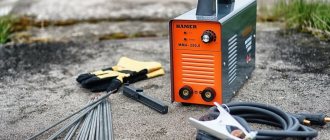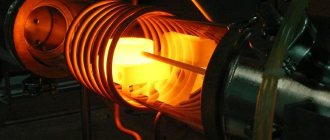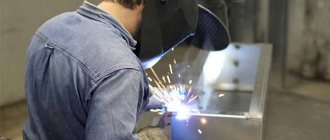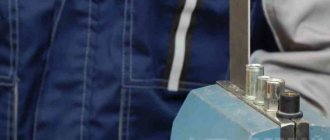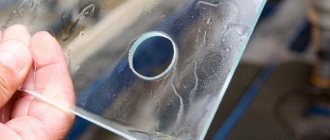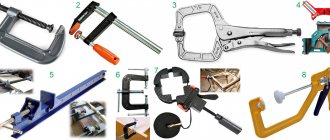The most common way to work with stainless steel is welding. The welding process has several features:
- a low level of weldability significantly affects the formation of the joint;
- the low thermal conductivity of stainless steel leads to the fact that the welded products melt through even at fairly low current values;
- a high coefficient of expansion means that when heated, the product seems to stretch. While when cooling, a tightening effect appears. Foreign metal, which is part of the structure of the main structure and has a lower expansion coefficient, leaves microcracks . Therefore, it is important to choose the right consumables;
- , intergranular corrosion occurs in stainless steel products . To avoid this, you need to carefully select the welding mode, as well as forcefully cool the parts being welded.
Welding with electrodes on stainless steel
Welding corrosion-resistant steels is a complex and time-consuming process. This procedure requires the performer to have theoretical knowledge and practical experience. Another important criterion for comfortable welding work is the correct choice of electrodes.
The special characteristics of stainless steel, as well as several welding features of this material, require the use of special welding materials . Welding stainless steel with a properly selected electrode is a guarantee of reliability, strength and long service life of the finished product.
How to weld stainless steel with a regular electrode
Very often, novice welders ask themselves: can they weld stainless steel with conventional electrodes? It is important to note that welding corrosion-resistant steels with conventional electrodes is technically possible . In the absence or shortage of special welding materials, you can use simple consumables. Many craftsmen have repeatedly used this approach, but exclusively for processing parts for household use . Since increased requirements for reliability and solidity are applied to industrial structures.
From a technological point of view, it is recommended to use specialized electrodes with a suitable coating. Welding stainless steel with simple electrodes negatively affects the quality of the connection, and microcracks may also appear .
Conclusion! Therefore, welding stainless steel with conventional electrodes should be used as a last resort, only in an emergency or if you have little risk.
The question also often arises: is it possible to weld stainless steel using conventional welding? This also implies the possibility of using simple consumables for working with corrosion-resistant steels.
Video
We invite you to watch a short video where a DIYer shows how he welded the heat exchanger of a sauna stove with a black electrode. The comments show that opinions are divided on the admissibility of such welding, which makes this approach controversial.
Peculiarities
Stainless steel has some features that can have a significant impact on the welding process:
- Linear expansion and shrinkage of the material . When heated, stainless steel products “expand,” and when cooled, they “contract.”
- The thermal conductivity of stainless steel is almost two times less than that of other materials. Therefore, when welding it, the current should be reduced by 15-20%.
- Corrosion-resistant steels have a fairly high electrical resistance . Therefore, it is recommended to use only special electrodes for welding stainless steel.
- If you choose the wrong welding mode or select the wrong machine, stainless steel may lose its anti-corrosion properties . This happens as follows: when the product is heated to a temperature above 500°C, chromium and iron carbide is formed on the metal along the edge. This leads to oxidation. To prevent rust formation, structures should be cooled quickly using various methods.
Stainless steel welding methods
There are several methods for welding stainless steels. Each method involves the use of specific equipment and consumables. How to properly cook stainless steel with electrodes will be analyzed further.
Manual electrode
Manual welding of stainless steels with a coated electrode is universal and can be used in almost any industry. This method provides acceptable connection quality, so it is used by home and professional performers. Another important advantage of MMA technology is the simplicity and ease of the welding process. In addition, welding stainless steel with arc welding has several more advantages :
- affordability of electrodes and equipment;
- the devices can work throughout the working day;
- the units have compact dimensions and low weight, which allows you to quickly move around the work site;
- high speed of work with skillful handling of equipment and consumables;
- strength of welds;
- There is an opportunity to independently study this welding method and apply it in practice.
In order for a weld to be highly reliable, it is necessary to select the right welding materials. The following brands are suitable for manual welding:
OZL-8 are designed to weld products exposed to aggressive environments. At the same time, increased requirements for resistance to MCC are not imposed on the deposited metal. Performers use OZL-8 electrodes to process critical structures.
NZh-13 electrodes create a reliable connection and prevent the formation of ICC. A thin layer of slag crust disappears spontaneously after cooling and compression of the working area. This significantly speeds up the process when a large number of seams need to be completed.
TsL-11 electrodes are characterized by good insulation of the weld pool from external factors. This brand provides a strong connection.
When using this technology, direct current is used to weld stainless steel, the polarity is reversed.
After analyzing this information, a performer of any level will be able to learn how to weld stainless steel using arc welding.
Manual argon
Manual welding of stainless steel in an argon environment is carried out using tungsten electrodes. This technology guarantees high-quality and reliable seams. Moreover, the connections meet all the requirements, even if they are made at home. Consequently, argon arc welding is used when the performer needs an aesthetic result. The seams do not need to be cleaned of slag. There are no sparks during welding. This is the cleanest connection method . This method is also intended for working with parts with very thin walls.
Welding is carried out with alternating or direct current of straight polarity .
The type of stress depends on the thickness of the metal:
- if the thickness of the sheets being welded is 1 mm, then a direct current of 30-60 A is used, the diameter of the electrodes is 2 mm.
- Welding stainless steel with alternating current is also possible when working with elements 1 mm thick: voltage – 35-75 A, electrode Ø – 2 mm.
- data for processed products with a thickness of 1.5 mm: direct current of direct polarity, 40-75 A, Ø welding rod - 2 mm;
- alternating current, 45-85 A, Ø – 2 mm.
Features of this method:
- the arc should be ignited in a non-contact manner so that tungsten from the electrodes does not get into the molten metal;
- welding must be carried out without oscillatory movements of the rod. Violation of this rule may lead to a violation of the protection of the working area, which will lead to oxidation of the seam.
Advice! Using this method, you can reduce the consumption of welding materials. To do this, it is necessary not to turn off the argon supply for 10-15 seconds after welding is completed. This procedure allows you to protect the hot electrode from active oxidation.
Necessary Precautions
When choosing any welding technology, observe the following safety rules:
- Do not use faulty devices. The main units of equipment are checked before starting work. The wires must not be damaged. If necessary, the cables are replaced.
- Only new electrodes with intact coating are suitable for use. The use of cracked rods is unacceptable.
- The workplace is set up in advance. Flammable liquids and materials, as well as foreign objects that could hinder the process, are removed from the welding zone.
- When working, use a welding mask, a special suit, gloves, and tarpaulin boots. A dielectric mat is laid near the equipment, eliminating the possibility of electric shock to a person.
- The room is equipped with a powerful ventilation system.
- The work is carried out on a special table. It is not recommended to keep parts suspended.
- When using inert gas or oxygen, there should be no traces of oil on the welding table.
We recommend reading: How to weld stainless steel with electrodes
Welding stainless steel with an electrode at home
To carry out welding at home, many performers use inverter-type devices.
Units of this type operate from a standard 200 V power source; their small dimensions and weight make it convenient to move and transport the equipment.
The relatively low cost has made this type of equipment a top seller among performers. Welding stainless steel using inverter welding creates a reliable connection.
When setting up the inverter, the following parameters should be taken into account:
- if the metal thickness is 1.5 mm, then the current should be 40-60 A, electrode Ø 2 mm.
- part thickness 3 mm: voltage 75-85 A, rod Ø – 3 mm.
- thickness 4 mm: current 90-100 A, rod Ø – 3 mm.
- thickness 6 mm. voltage 140-150 A, consumable Ø – 4 mm.
Welding is carried out with direct current of reverse polarity.
The welding process includes several stages:
- Rust, oil and other contaminants should be removed from the working surface , cleaning is carried out with a metal brush;
- The edges of a product whose thickness exceeds 4 mm must be cut. This ensures a good level of penetration and filling of the weld pool. Cutting is done with a grinder or file;
- when working with thin metal , you need to tightly bring the welded edges together and make tacks;
- product with a thickness of more than 7 mm. should be heated to 150°C. When carrying out household welding, it is recommended to do this with a blowtorch;
- work begins with igniting the arc. The electrode is brought to the surface and touched several times, thus activating it.
- connections are made on a short arc ;
- a “lock” should be made at the end of the seam to avoid the formation of cracks and fistulas;
- after finishing the welding process, you need to let the product cool, it is not recommended to do this forcibly;
- the slag crust is removed with a hammer or cleaned approximately five minutes after completion of work;
- The last step is polishing and grinding .
Useful video
This method requires electrodes used to work with corrosion-resistant and heat-resistant metals.
Electrodes intended for inverter welding of corrosion-resistant steels:
The seam made with OZL-6 electrodes is heat resistant and not prone to the formation of cracks and pores. This brand is characterized by high performance properties.
ANO-27 electrodes are intended for welding critical structures operating under static and dynamic loads, as well as at negative temperatures.
For other grades, see the sections for corrosion-resistant high-strength steels and for corrosion-resistant acid-resistant steels.
What electrodes should be used to cook stainless steel with ferrous metal?
In production, where all processes are carried out exclusively in accordance with technology, most often the question does not arise: how to weld stainless steel to ferrous metal? After all, the connection of such different metals under normal conditions is incorrect, from a technical point of view . Also, the need for such a procedure, as a rule, is practically absent. But sometimes there is such a need. And for this purpose special electrodes are produced.
Also, at home, a process of this kind is quite possible. But to do this, you need to know the chemical composition of the products being welded in order to choose the right consumables . After all, stainless steel and ferrous metal are dissimilar materials. You should also take into account such a parameter as weldability, i.e. the ability of these materials to form permanent connections of satisfactory quality.
There are two ways to connect:
- welding of stainless steel and ferrous metal with a coated electrode;
- welding with tungsten consumables.
When using MMA technology, welding materials designed for non-ferrous metals and alloys should be used.
Welding electrodes ANZHR-2.
The most common brands are ANZHR-1 and ANZHR-2. The main advantage is the ability to carry out welding in almost all spatial positions, except vertical “top-down”.
TsT-28 electrodes are also a suitable option. Advantages: the seam formed using welding materials of this brand is characterized by high heat resistance and heat resistance.
In addition, the performer can use special stainless steel electrodes.
ESAB electrodes for welding dissimilar alloys are in demand among performers: OK 67.42, OK 67.45, OK 67.52, OK 68.81, OK 68.82, OK 92.26.
The second method is less popular due to the higher cost of tungsten electrodes. The performer will also need special welding equipment. During the welding process with this technology, it is necessary to carefully monitor the position of the rod. To obtain a high-quality and reliable connection, you need to hold the rod perpendicular to the surface of the products being welded.
Depending on the thickness of the materials, different currents and polarities are used when welding stainless steel:
- product thickness 1 mm: constant voltage, force 30-60 A, rod Ø – 2 mm;
- the thickness of the parts is 2 mm: alternating current with a force of 50-80 A, rod Ø – 3 mm;
- thickness is 4 mm.: direct current, voltage – 90-130, consumable Ø – 4 mm.
Useful tips
Experienced welders give novice welders the following advice:
- When welding dissimilar metals, it is advisable to use consumables containing nickel. Before starting work, the rods are calcined for an hour.
- The welding machine must produce direct current.
- You cannot skip the pre-processing stage of parts. If dirt or rust is present, the seam becomes brittle.
- When gas welding, forced cooling methods cannot be used. The part must cool naturally.
- The application of flux helps to increase the strength of the connection.
- The tips of non-fusible electrodes need to be sharpened regularly.
- When welding, try to capture as much ferrous metal as possible. This helps establish a strong molecular bond.
- The electrode must be guided slowly and carefully.
Following the recommendations helps you quickly master the methods of welding parts made of dissimilar metals.
Welding thin stainless steel
Welding thin metal requires a certain level of knowledge and skills from the performer. When working with thin-walled products made of corrosion-resistant steels, it is important not only to choose the right electrodes, but also to correctly determine the voltage. How to weld thin stainless steel with an electrode and what current is used to weld stainless steel will be discussed below.
Compared with ordinary steel, welding of thin stainless steel with an electrode should be carried out at a lower current . The number of amps required is approximately 20% less.
The diameter of the welding rod plays an important role. When the thickness of the welded product is 3 mm. diameter of the consumable is 3-4 mm.
Rods no longer than 35 mm should be used. The heating temperature should not exceed 500°C.
It is not recommended to cool the product abruptly.
Household welding of thin stainless steel is carried out using an inverter. It is recommended to follow the following rules:
- do not heat the workpieces and the joint above a temperature of 150°C;
- the welding process is carried out at low current values at high speed ;
- without oscillatory movements of the electric arc;
- under the workpieces that will “take away” some of the heat . This will prevent the work area from becoming too hot and causing holes to form.
Metal up to 3 mm thick. cooked without cutting. There should be a gap of 1-2 mm between the workpieces.
When carrying out inverter welding using electrodes with a diameter of 3 mm, it is necessary to set the voltage to 80 A.
Craftsmen use the following grades of electrodes to connect thin corrosion-resistant steels:
TsL-11 is a common and popular brand of welding materials. The weld material deposited with TsL-11 is resistant to corrosion under unfavorable conditions.
OK 63.20 is intended for work with thin-walled elements operating in contact with liquid aggressive non-oxidizing media at temperatures up to 350°C.
Welding of stainless steel pipes
Welding stainless steel pipes with electrodes is a popular type of joining such products. Welding work with pipes is carried out using electrodes with basic or rutile coating. The welding process with a consumable consumable is carried out using direct current of reverse polarity.
Welding stainless steel with direct current has several advantages: low metal spattering; simplicity of the process for the welder; suitable for working with thin-walled pipes; high quality seam.
Tungsten electrodes for welding stainless steel pipes operate on direct current of straight polarity. Advantages of this method:
- reliable protection against exposure to oxygen, which can lead to oxidation;
- stable arc;
- the connection has high corrosion resistance.
Regardless of the chosen connection method, the technology for welding stainless pipes includes three stages:
- The preparatory part is divided into two parts: preparation of the performer and preparation of the main material. The welder must be provided with special clothing and a protective mask. Stainless steel pipes need to be cleaned of various contaminants : corrosion, paint, etc. The joints and the area around them should be treated with a wire brush or sandpaper.
- The welding process begins with ignition of the electrode and initiation of the arc. It is important to hold the arc during the work. Then the connection is made.
- An important step is checking the quality of the seam . Before this, it is necessary to beat off the slag.
Electrodes for stainless steel pipes:
OK 63.20 are intended for spot welding, i.e. the process is carried out by briefly igniting and extinguishing the electric arc.
A short video for clarity.
Welding wire selection
Solid wire
It gives good seam quality, despite the fact that it has a low cost.
Cored wire
It produces a lower quality seam, but allows welding work to be carried out without the use of gas cylinders.
Copper-plated
It is mainly used for welding in carbon dioxide and its mixtures. The use of this type of wire leads to an increase in arc stability.
Filler wire is produced from 0.13 to 6 mm in diameter.

